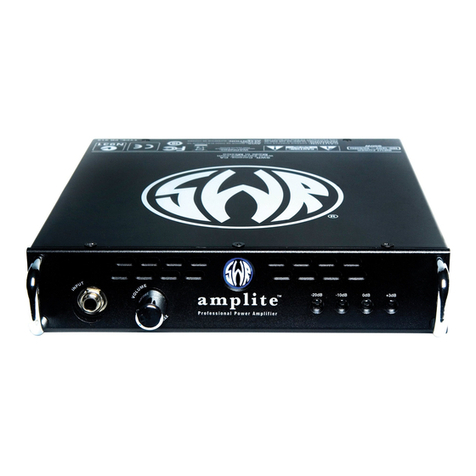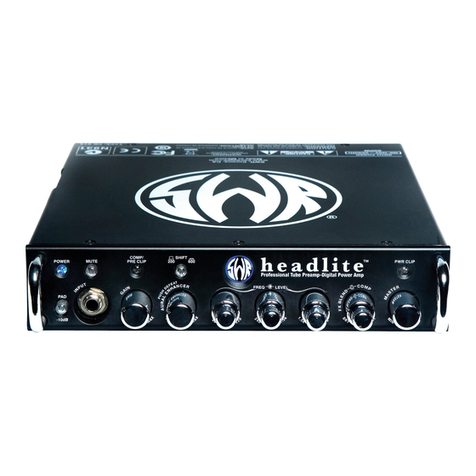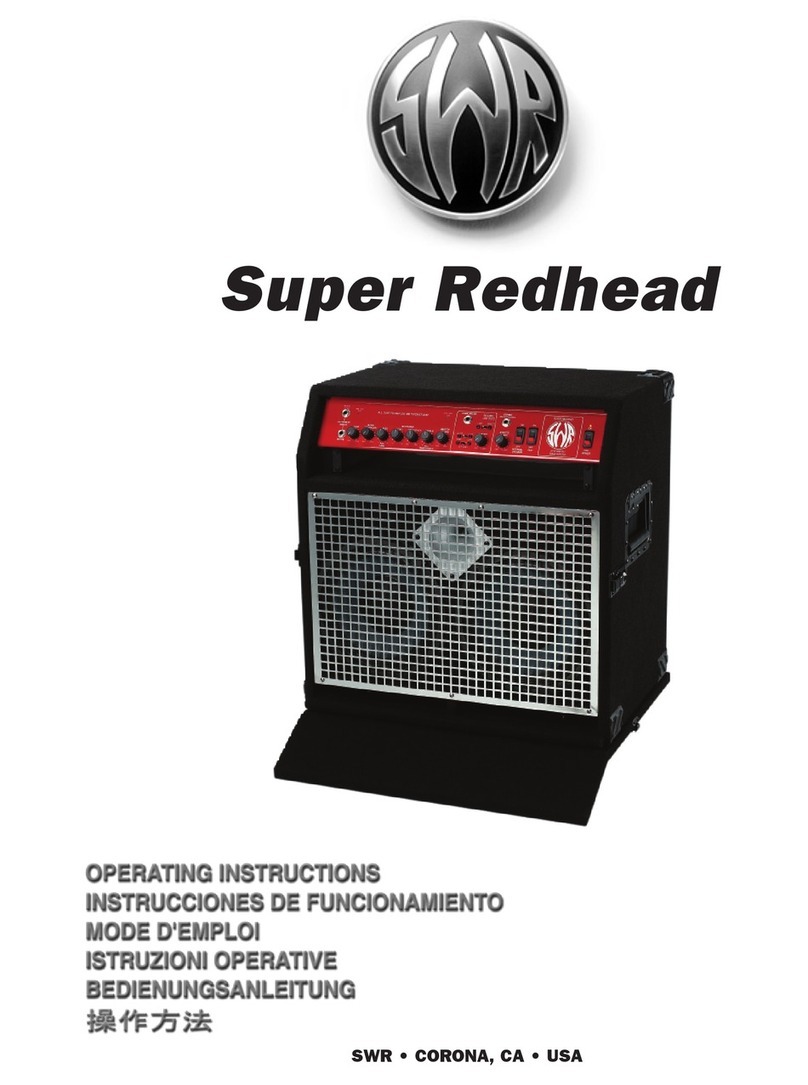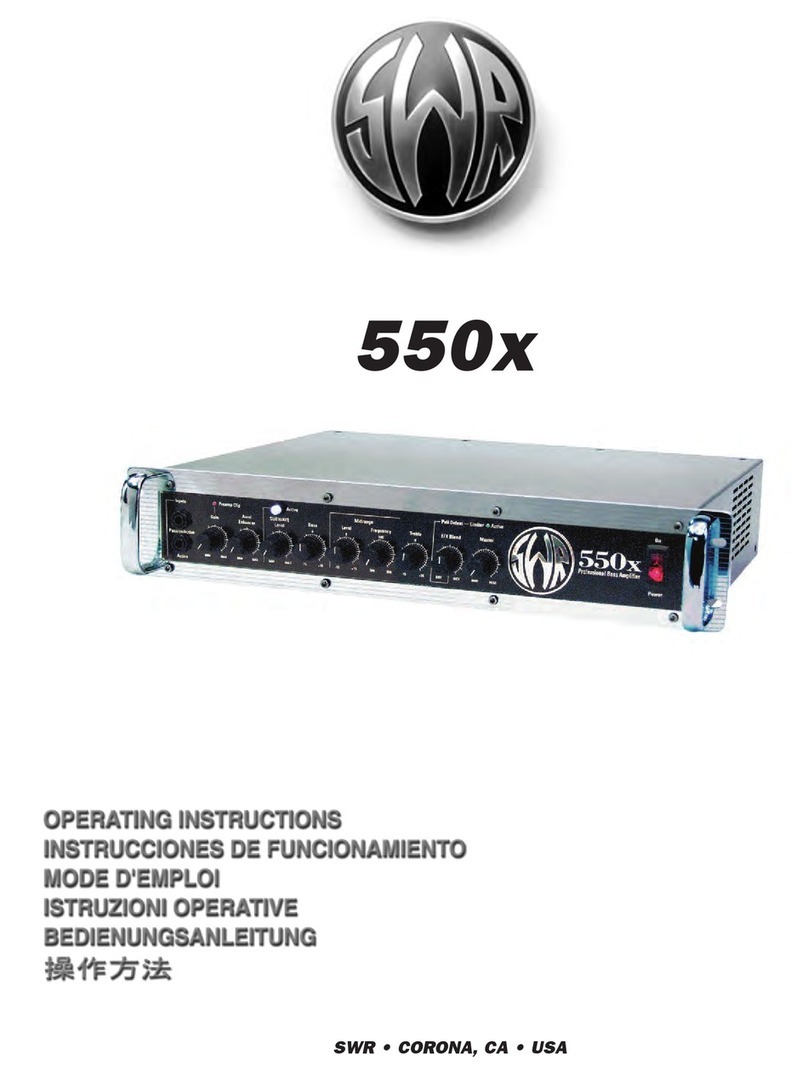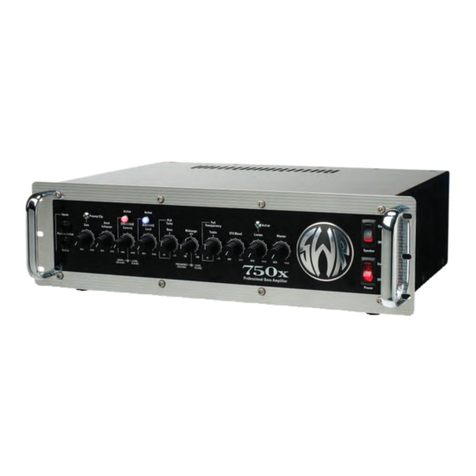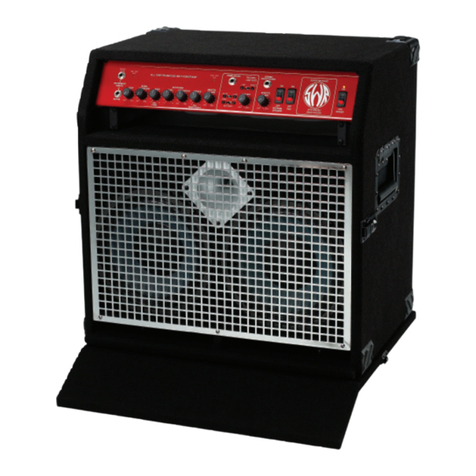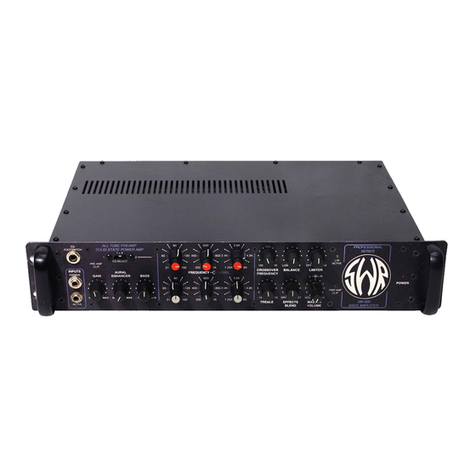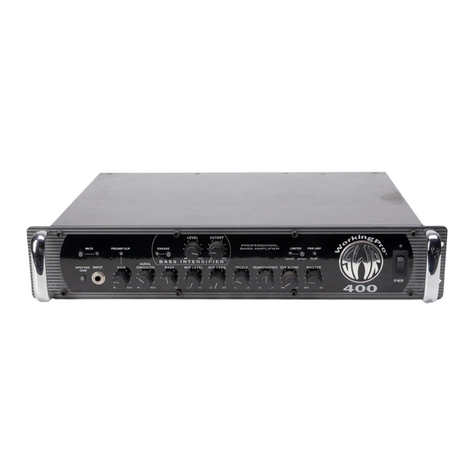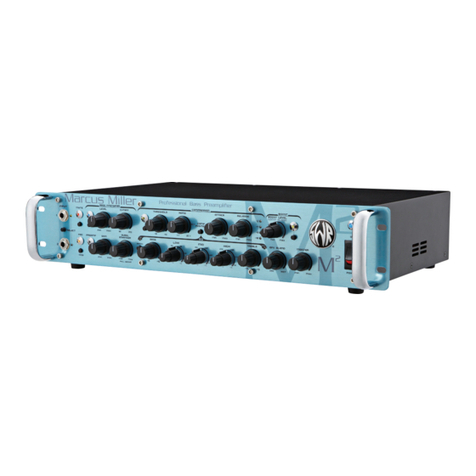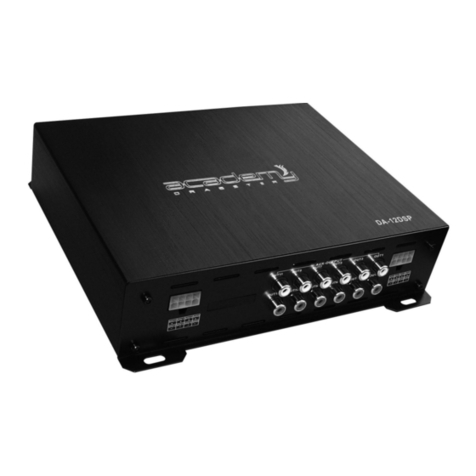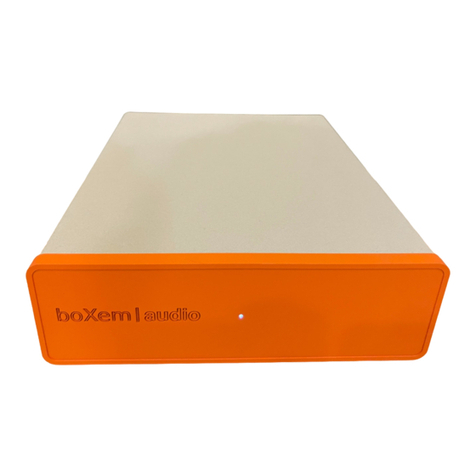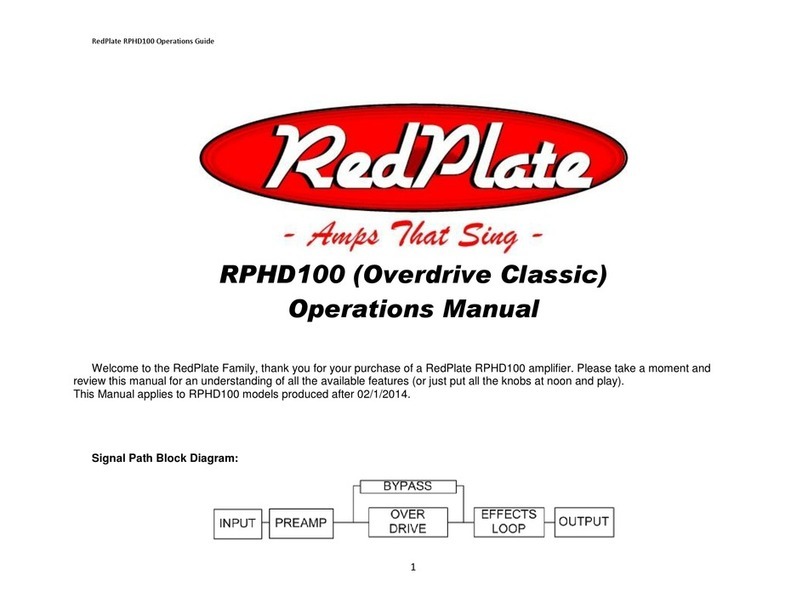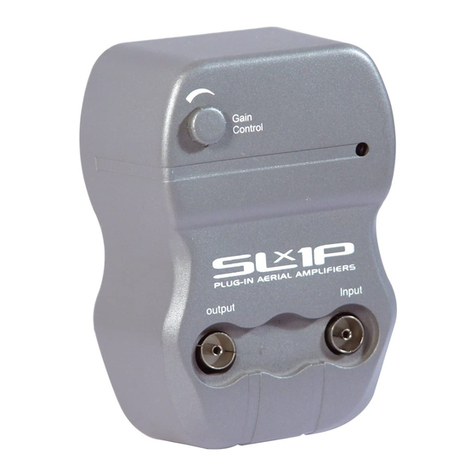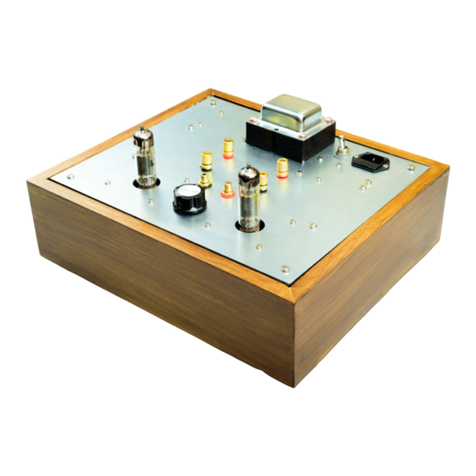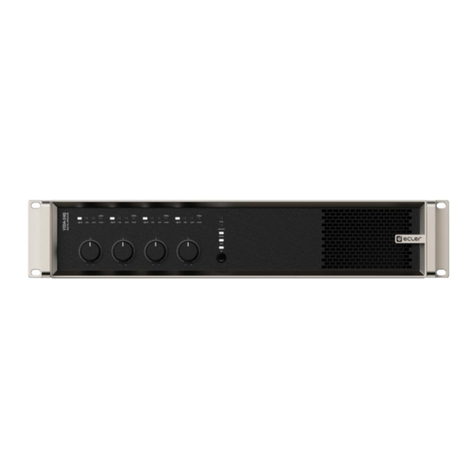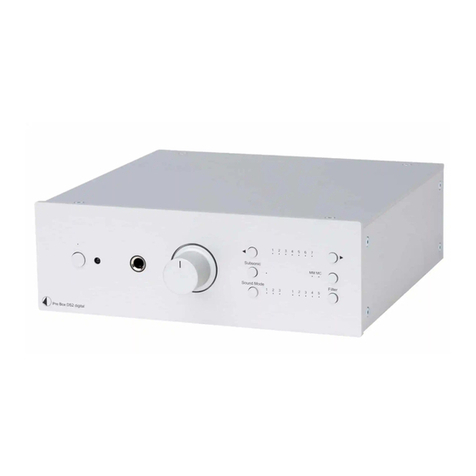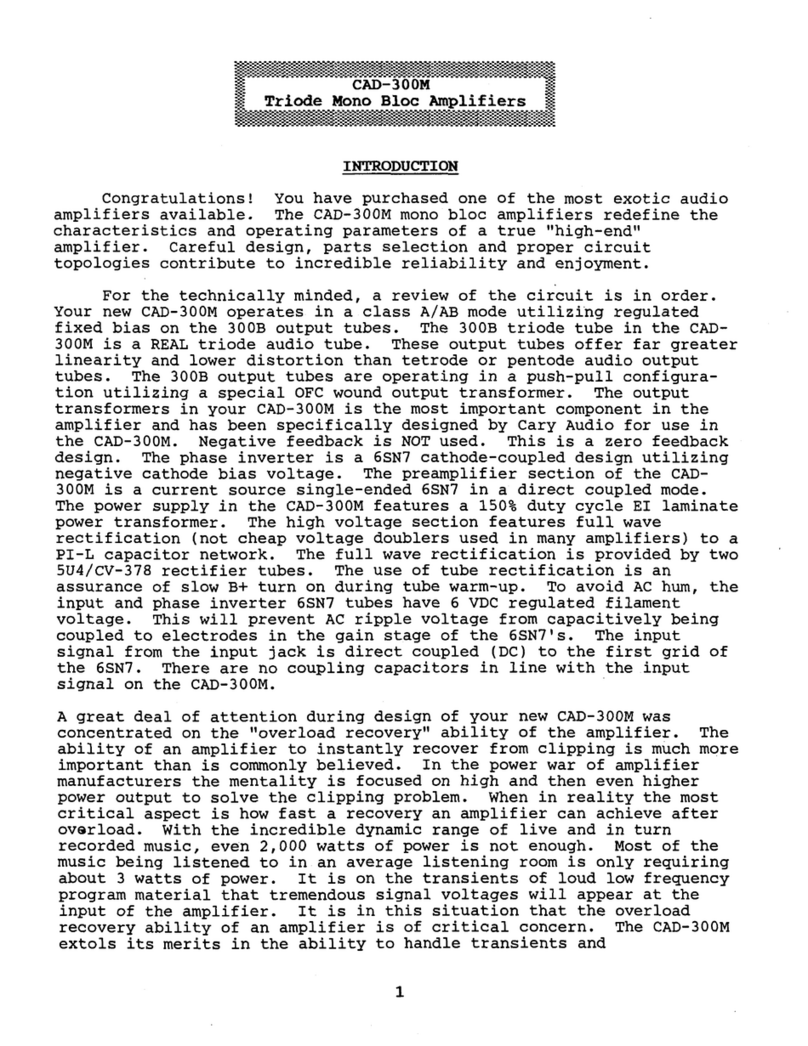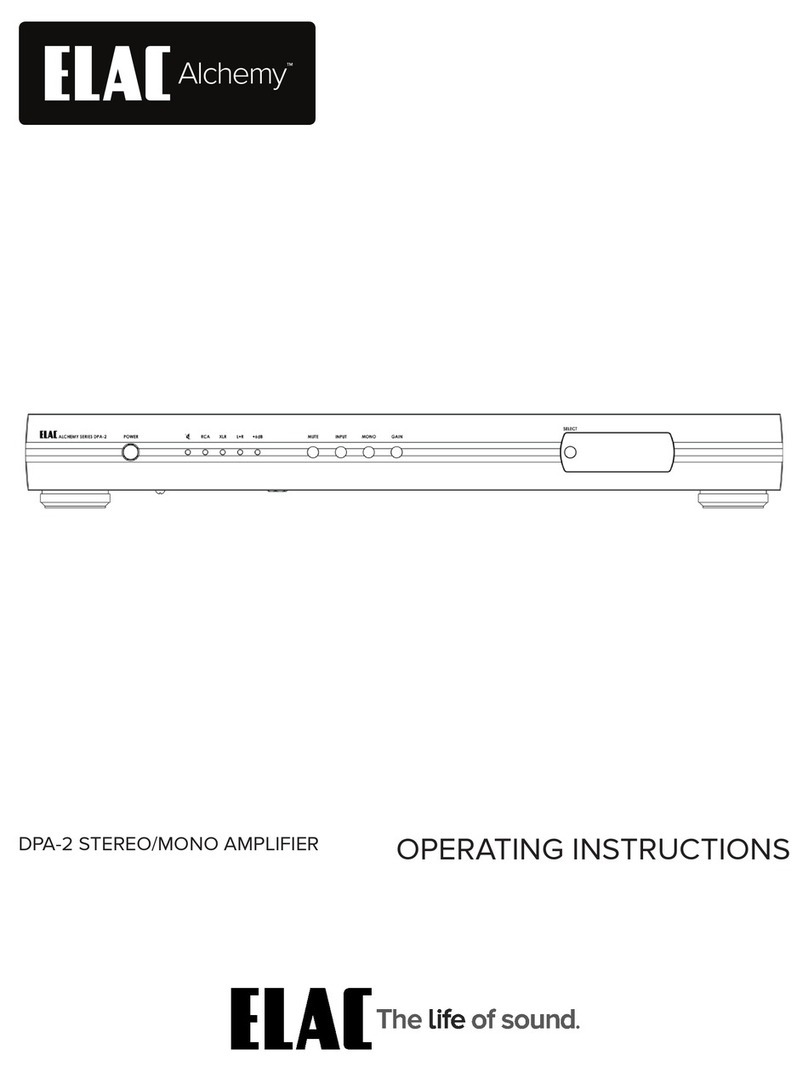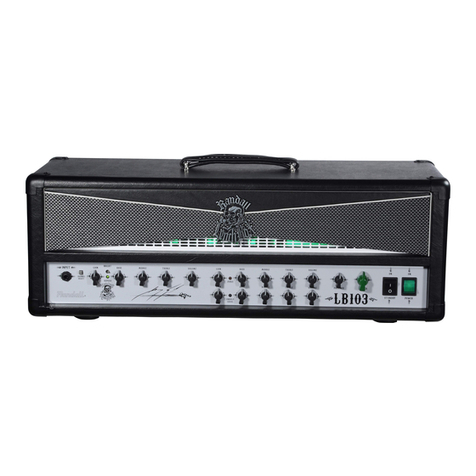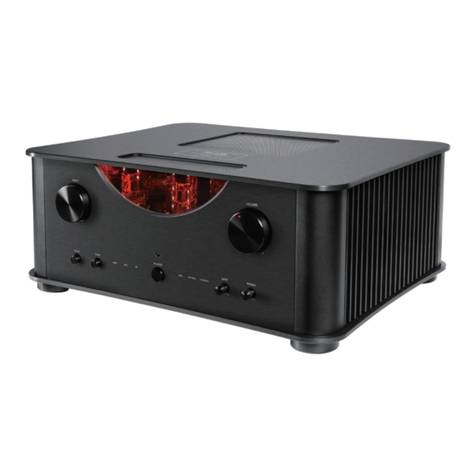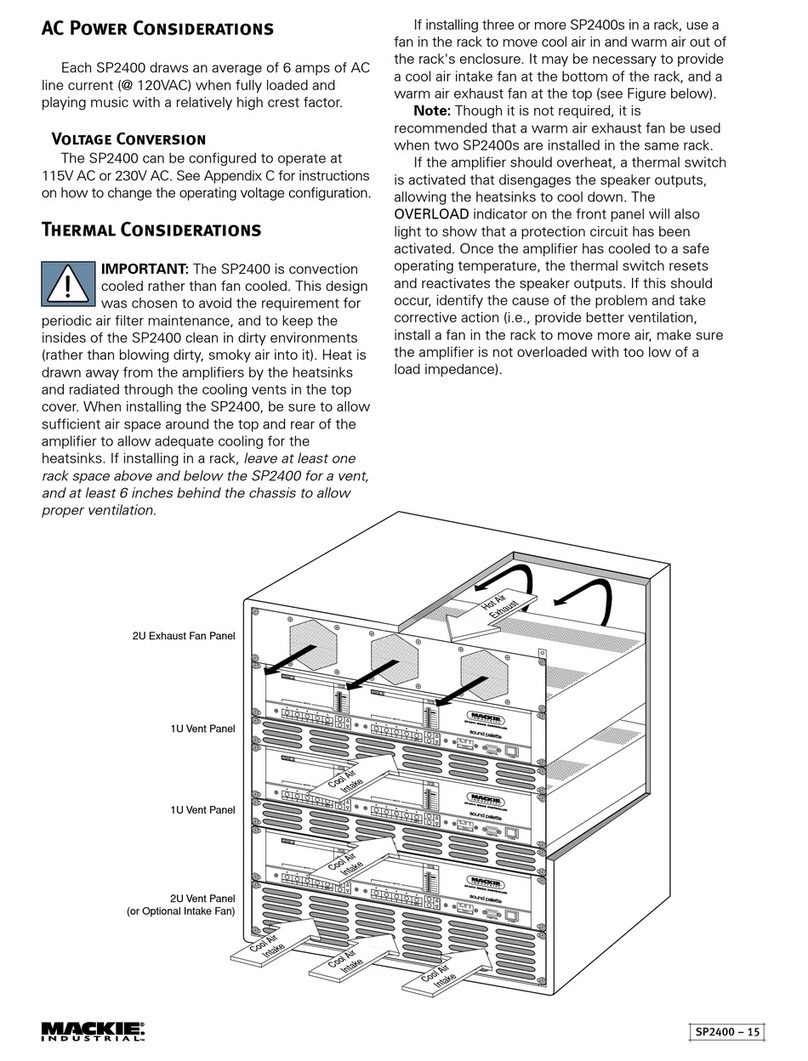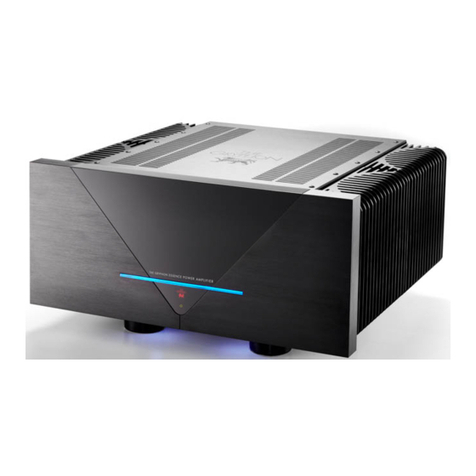SWR WORKINGMAN'S 4004 User manual

Workingman’s 4004
OWNER’S MANUAL
SWR • CORONA, CA • USA

WORKINGMAN’S 4004 • 2
INTRODUCTION
Founded in 1984, SWR specializes in quality amplifiers and speakers addressing the needs of the pro-
fessional and semi-professional bassist. Widely known as the makers of the finest bass systems in the
world, SWR has recently gained popularity among instrumentalists of all types, stemming from the intro-
duction of a series of products intended for the acoustic musician. SWR and its advisory board, consist-
ing of some of the world's finest musicians, have constantly strived to identify the changing needs of
musicians everywhere, and to respond with new and useful designs, each one unique unto itself.
Numerous requests from our customers to produce a line of products that would incorporate accurate
sound, high reliability, quality components, hand-made craftsmanship, and an overall low price, resulted
in the development of the Workingman's Series of amplification from SWR.
The precision electronic section featured in the Workingman's Series of amplifiers is entirely hand-built,
employing a variety of technologies selected for their sound quality and practical usefulness in a road-
worthy and studio-ready amplifier, including an all-discrete initial gain stage in the preamplifier section
and discrete solid-state design in the power amplifier. Regardless of its lower price, the Workingman's
Series offers no compromises of the essential SWR design and construction philosophy. Corners are not
cut from a more elaborate model: rather, each product's design parameters are conceived from the
ground up and the best available components are selected for each application. Once again, with sound,
reliability and price consciousness in mind.
The tone-shaping section of all Workingman's Series amplifiers, including the Aural Enhancer (found in
all SWR Preamps and Integrated Amplifiers) and the Tone Controls, will not impose a character on your
sound. They will instead make the interface between your instrument and the speaker system (two of
the largest factors in your final tone) a simple matter requiring minimal effort. The center frequencies of
the Tone Controls were chosen for their musical effect on most basses.
SWR amplification is handmade and individually tested in the United States. Everyone at SWR sincerely
hopes that you are satisfied with your recent purchase, as we are extremely proud of the quality and
attention that goes into each and every SWR product. We truly hope that your purchase of an SWR helps
bring out the best in your playing and adds to your enjoyment of music.
WORKINGMAN'S 4004 - POWER SPECIFICATIONS
400 watts @ 4 ohms
260 watts @ 8 ohms
Minimum Impedance: 4 ohms
WORKINGMAN'S 4004 - RACK CASE ENCLOSURE
The Workingman's 4004 comes enclosed in a sturdy, custom fitted rack, covered in midnight blue carpet
with stack lock corners. The rack case was designed specifically to house the Workingman's 4004 chas-
sis and features a single open rack space (directly below the amplifier) for mounting the effect unit of
your choice. Most single rack space effect units or digital tuners on the market today will mount perfect-
ly into this space.
Dimensions: 23.5" W x 7.5" H x 13.5" D
Weight: 24 lbs.

WORKINGMAN’S 4004 • 3
WORKINGMAN'S 4004 - FRONT PANEL FEATURES
BALANCED DIRECT RECORD OUT
The Balanced XLR output is a true balanced output. No front panel controls affect its signal. The tone
and output level are controlled only by the instrument plugged into one of the input jacks. To use this
feature, run an XLR (Cannon) cable from the Balanced D.I. to the input of a tape machine, mixing con-
sole, etc. This output is also suitable for sending a signal to a house mixer in live situations.
Wiring for the XLR connector is American standard (as follows):
Pin 1 = ground, Pin 2 = +, Pin 3 = -
TUNER OUT
The "Tuner Out" send jack allows the user to connect their instrument tuner to the Workingman's 4004
without having to unplug and go back and forth from amp to tuner to amp. Like the Balanced D.I. out-
put, this feature is isolated from the rest of the circuitry and no other controls other than your instru-
ment have an affect on this feature. Being on a sidechain (isolated) also avoids loading down of the
instrument causing a loss in its dynamic range.
To use this feature, plug in a shielded patch cord from this jack to the INPUT of your tuning device. Turn
the amp on and you're ready to go. If you don't want to monitor your sound while tuning, turn down the
Master Volume control or position the selector switch on the back panel to the "headphones" (middle)
position.
INPUT JACKS
Two separate and independent input jacks are provided so that the best signal to noise ratio can be
obtained without overloading the preamp section. The Passive input has over twice the gain than that of
the Active input. Both inputs can be used simultaneously without affecting the volume or tone of the
other. One use of these inputs would be to plug your bass into the Passive input and practice along with
a drum machine by plugging it into the Active input. Please see below for a detailed explanation of these
inputs.
PASSIVE/ACTIVE INPUT
This input can and should be used if your instrument has passive electronics (no built-in preamp). Some
pickups, such as EMG, etc., employ batteries for operation and will work perfectly using this input.
Technically speaking, this input should be used if your instrument has an output voltage of 1 volt RMS
or LESS. Consult the owner's manual that came with your instrument or ask the manufacturer if you are
unsure.
Please Note: Generally speaking, you should try the Passive input jack first. Some built-in preamps,
such as those made by Bartolini and Music Man, can be used with this input depending on their internal
gain settings. If you hear a small amount of distortion and the Preamp Clip LED is not activated, try
using the Active input jack. And please note, some passive pickups DO distort. Because of the hi-fi
nature of all SWR products, even the smallest amount of distortion originating at the source (instru-
ment) may be heard.

WORKINGMAN’S 4004 • 4
ACTIVE INPUT
The Active input jack should be used with instruments having a built-in (on-board) preamp that will pro-
duce signals over 1 volt RMS. Known basses that should use the Active input only are the Kubicki X-
Factor and some Ovation electrics. Some really "hot" pickups installed in your instrument may find the
Active input more compatible. The best judge is your own ears.
Please Note: Using the Active input with passive basses may result in a loss of high-end transients.
Players who roll off their high-end starting at around 2K to 3KHz may find this input more to their liking.
If you hear some distortion from your active bass and are using the Active input jack, CHECK YOUR BAT-
TERY!! Also, make sure the Preamp Clip LED is not lighting.
PREAMP CLIP LED
The Preamp Clip LED will light whenever the Preamp, Tone section or output buffer reach clipping (run
out of headroom). In the event the Preamp clip indicator lights, turn down the Gain control. Since the
Preamp Clip also monitors the Tone section, boosting any one of the tone controls can cause the LED to
activate. Again, turn down the Gain control if this happens.
Please Note: Constant clipping of the preamp will not harm the electronics in your Workingman's 4004.
However, damage can occur to speakers due to near-DC content present in a clipped waveform. Do not
defeat the limiter when overdriving the preamp.
GAIN CONTROL
The gain control adjusts the volume of the preamp section. After the Tone controls, Aural Enhancer and
any effects you may be using have been set to your liking, the Gain control should be set to where the
Preamp Clip LED barely flashes upon hitting your loudest note. After setting the Gain, use the Master
Volume to set the desired volume level. Using these controls in this manner assures the maximum sig-
nal-to- noise ratio with no distortion caused by the preamp circuits clipping. Since the Gain control is
similar to a "pad", a small amount of signal will get through with the Gain control turned all the way
down. The Gain also adjusts the level sent to the Effects send jack. If your effect is being overdriven,
turn down the Gain Control.
USING THE TONE CONTROLS
To get the most out of the Tone Controls of your Workingman's 4004, it would be best to first under-
stand how the Aural Enhancer works, and how it interacts with the 5 band EQ section. Think of it as a
variable tone curve, changing with its position. As you raise the control from its "0", or fully counter-
clockwise position, you are elevating the whole range of sound (lows, mids, and highs) at frequency
points different than those selected for the individual EQ bands. This remains true up to about the "2
o'clock" position, at which point the mids start to drop off. The curves involved here are gentle, as
opposed to the very extreme curves you can create with the EQ Controls. Most significantly, the Aural
Enhancer will raise the low end at a point lower than the Bass control itself. For a 4-string bass, the
Bass control itself will suffice. For the 5-string player, the Aural Enhancer will help bring out the funda-
mentals of your instrument in the 30-60Hz range.

WORKINGMAN’S 4004 • 5
TONE CONTROL SECTION
The Workingman's 4004 Tone Control section is a five-band set of level slide controls centered around
the frequencies 80 Hz (Bass), 160 Hz (Low Mid), 400 Hz (Mid), 800 Hz (Hi Mid) and 3KHz (Treble). Each
control can cut or boost its band a maximum of 15dB. Each slider has a flat (center click) position that
defeats its function. In this position, the band is inactive. For each EQ control, sliding the knob down
from the center "click" position will reduce or cut its designated frequency. Sliding the knob up will
boost its designated band or frequency.
BASS CONTROL
The Bass control (band 1) itself, as stated above, works in a range that will be useful under most "nor-
mal" conditions. Its musical use might be thought of as a "fatness" control. Leaving the Aural Enhancer
in a position lower than 12 o'clock will not boost the extreme bottom so much as to make indistinct the
working of the Bass control. The overall "punch" of your instrument, from your low E-string on up about
two octaves (midway up the G-string), will be determined with this control. With passive instruments, this
will be straightforward. With active instruments having bass-boost controls, more exploration will be
worthwhile. (Some active tone circuits have boost-cut controls such as MTD, Sadowsky, etc. Others such
as Music Man, may be straight boost controls).
MID RANGE CONTROL
The Mid Range (bands 2, 3, & 4) control operates in a crucial area for most instruments. Many basses,
particularly with roundwound strings, can have a very "honky", or nasal, sound. Dropping the Mid Range
control can go a long way toward smoothing out your tone. We suggest, though, that what sounds best
when your listening to your tone by yourself may not be what works best in a band or recording.
Sometimes that objectionable quality may be just the right "hair" on your note to still have an audible
presence in the track or on stage.
TREBLE CONTROL
The Treble control (band 5) operates in a tonal area that extends through and beyond the usual Treble
control range. The Transparency control "kicks in" at a much higher frequency. Boosting the control will
open up the sound of a dull instrument, particularly in conjunction with a tweeter, should you have one
in your speaker system. However, this is also the range of string rattle, finger slides, pickup clicks, etc.
Again, we recommend you experiment with the control alone with your instrument while finding your
tone, and listen again in a band context, both near to and away from your speaker system. Qualities like
punch, fatness, presence and bite can be fairly well spread out. Treble, despite the broad dispersion of
most tweeters, is a very directional quality. Spend some time exploring what you can hear in this area
as you move around.
AURAL ENHANCER
The Aural Enhancer was developed to bring out the fundamental low notes of the bass, reduce certain
frequencies that can "mask" fundamentals and enhance the high-end transients. The effect becomes
more pronounced as the control is turned up. The result is a more transparent sound. Listening to a
passive bass with the control set all the way down, and then turning it all the way up, can be likened to
listening to the bass suddenly become "active".

WORKINGMAN’S 4004 • 6
EFFECTS BLEND CONTROL
The Effects Blend control mixes the signal coming from your instrument with the sound coming from
your effect. With the Blend control fully counter-clockwise, no signal from your effect will be heard. As
you turn this control clockwise, more of the effect can be heard in the overall sound. When the Blend
control is fully clockwise, no dry or unaffected signal is heard other than the output of your effect
device.
This type of control and patching arrangement is very effective in reducing noise caused by effects
devices and in maintaining a more natural sound. If your effects device has a similar control, we sug-
gest leaving it set to its maximum effect/minimum dry signal position and using the Effects Blend con-
trol for this function. Please read the "Effects Loop" section for more information.
Variable Limiter Control
The 4004’s soft knee-type limiter is there to help you protect your power amp from harmful states of operation. The
circuit is located after the Master Volume and before the power amplifier, so it’s driven by the Master Volume con-
trol. Its threshold (starting point) is preset by the factory so that you can get maximum overall apparent volume
without unduly overdriving (or “clipping”) the power amplifier—which, over time, can eventually damage the unit’s
internal circuitr y, as well as damage speakers connected to your amp.
Using the control is simple. Turning the Limiter Control clockwise (toward “MAX”) increases the amount of limiting
on your signal, while turning it counter-clockwise decreases the amount. When trying to find the highest possible
level of power amp operation under clipping, simply use the Master Volume and Limiter Controls together to find: a)
The highest setting possible on the Master Volume; and b) The lowest possible setting of the Limiter… all while
hearing no power amp distortion whatsoever.
Limiter Active LED
When the threshold (starting point) of the Limiter circuit is reached, the Limiter Active LED will light, indicating that
the Limiter Circuit is active and helping to protect your power amplifier and speakers from power amp clipping. The
Limiter LED will not illuminate when playing at levels not high enough to engage the circuit.
Note: If you have the Limiter set at “MIN” and you hear a loud, sharp distortion present in your sound—
and the Preamp Clip LED is not lighting up—engage the Limiter by turning up the control. If the distortion
goes away, you were probably clipping the power amp, which is not a good thing. Remember, the Limiter
circuit is there to protect your amplifier from such a state of operation.
MASTER VOLUME
The Master Volume adjusts the signal level going to the power amplifier. It DOES NOT control the output
of the effects send jack or Balanced Direct Record XLR output. It DOES affect the output at the
"Speakers" jacks and headphones jack. Losses caused by effects units can be recovered by increasing
the Master Volume.
SPEAKER ON/OFF SWITCH
The top position labeled "ON" completes the circuit from your power amplifier to the speaker jacks locat-
ed on the back panel. In other words, in turns your speakers on (provided they are hooked up). The bot-
tom position labeled "Speaker" (down) interrupts this path and turns your speakers off. The "Speaker”
(down) position allows you to: tune up silently; use headphones "only" with speakers still plugged in;
change or add speaker cabinets with the unit still on; silent turn-on or turn-off transients.
If no sound is coming from your speakers, check the position of this switch. If the switch is in the “ON”
position, check the speaker fuse, cables, etc.
Please Note: This switch does NOT affect the Headphone jack.

WORKINGMAN’S 4004 • 7
STEREO HEADPHONES JACK
By inserting a set of stereo headphones into this jack you will be able to monitor your sound or practice
without disturbing your neighbors. The headphone volume level is adjusted by the Master Volume. We
suggest you begin with the Master Volume full off (counter-clockwise), then slowly bring up the volume to
the desired level. If you hear some distortion in your headphones that is not present with the speakers
on, turn down the volume as you are probably overdriving your headphones and could ruin them.
Any impedance headphones will work. However, optimum impedance is 75 ohms.
WARNING: DO NOT USE MONO HEADPHONES. USE STEREO HEADPHONES ONLY!
POWER SWITCH
Pressing the Power Switch to the ON position activates the Workingman's 4004 electronics as indicated
by the red switch itself illuminating in red.
Please Note: Because of the tight regulation in the power supply, a transient (pop) may occur when
turning the unit on or off . This is normal and will not harm you speaker. If you wish to avoid this condi-
tion, turn the Speaker Switch to the "Stand By" position before turning the unit on or off.
REAR PANEL FEATURES
EFFECTS LOOP
The Effects Loop is located POST EQ and PRE Master Volume in the signal path. The level appearing at
the Send jack is controlled by the Gain control on the front panel. If you are getting too hot a signal to
the input of your effect, reduce the level of the Gain control and raise the level of your Master Volume
control to retain similar overall volume levels. By using the Gain, Master Volume and Effects Blend con-
trols, optimum performance should be easily obtainable with any effects device.
The Effects Loop is designed as a "sidechain" (parallel) function similar to those found on mixing con-
soles. Use of the Effects Loop should greatly reduce noise generated by effects devices (as compared
to in-line effects loops). Additional features of this type of loop can be found below under the Receive
jack section.
SEND JACK
Run a shielded patch cable from the Send jack to the input of your effects device. This jack may be
used as an additional line level output, in which case its level is determined by the setting of the Gain
control.
RETURN JACK
Run a shielded patch cable from the output of your effects device to the Return jack.
One unique feature of the Return Jack is the ability to practice along with pre-recorded music. Insert a
sound source into the Return jack (make sure it is a mono source). Use the Effects Blend control to mix
the level of the recorded music with your instrument's level. The combined signal will be heard through
your speakers, headphones, or both. The send jack is not used.

WORKINGMAN’S 4004 • 8
Please Note: Inserting a plug into the Return jack activates the Effects Blend control by receiving a
"command" through the ground created. Therefore, only a mono (2-conductor) phone plug should be
used. If you have a stereo (3-conductor) plug only, tie the ring and the sleeve (ground) together.
If you are not getting any "effect" through the speakers, check the position of the Effects Blend control.
SPEAKER JACKS
Use an unshielded 2-conductor cable (NOT A GUITAR CORD!) to connect any speakers to your
Workingman's 4004. Use a high quality, heavy gauge cable of at least 18 gauge (the lower the gauge,
the heavier the cable). The total impedance of the speakers should be 4 Ohms or greater. This means
you can use one 4 ohm cabinet, two 8 ohm cabinets or four 16 ohm cabinets.
RECOMMENDED SPEAKER ENCLOSURES FROM SWR INCLUDE:
Workingman's 4X10T, Workingman's 1X15T, Goliath III, Son Of Bertha, and the Big Ben Subwoofer (you
can use any two of these as they are all 8 ohms).
You may use one of the following:
Big Bertha, Goliath Senior, Henry 8x8, Triad I (these are all 4 ohm enclosures, therefore, only one can
be used).
SPEAKER FUSE
The speaker fuse is provided to protect the power amplifier from a fault in the speaker cable or the
speakers themselves. It can also open (blow) if an impedance less than 4 ohms is used or in the unlike-
ly event of a power amp failure. Size and rating of the fuse is 3AG 8 amp fast-blo. Do not defeat the pur-
pose of this feature by using a higher rated fuse.
A/C LINE FUSE
The line fuse can open (blow) due to power surges or high powerline transients. This fuse will also open
in the event of an electronics failure inside your amplifier.
Correct size and rating of the Line (Mains) fuse: 3AG 5 amp slo-blo for 120V operation, and 1 1/2 amp
slo-blo for 230V-240V operation. DO NOT REPLACE THIS FUSE WITH ONE OF A HIGHER RATING. IT MAY
VOID YOUR WARRANTY AND DAMAGE YOUR AMPLIFIERS ELECTRONICS.
A/C LINE CORD RECEPTACLE
Accepts a standard A/C power cable (supplied with the Workingman's 4004 in the United States), used
with almost all current musical, professional and household electronic devices. We recommend taking
great care when packing up. Put the cable in your instrument case, accessory case, etc. If it does
become misplaced, replacement will be easy at almost any appliance store, super market or the like.
Please Note: the rating for this cable is 3-conductor, 10 amperes. This is a rating of the current capaci-
ty of the cable, designated for higher power-drawing devices like amplifiers. If replacement is necessary,
or if you wish to buy a longer cable, look for the rating on the cable and be sure it is at least 10 amps.

WORKINGMAN’S 4004 • 9
SUGGESTED SETTINGS

WORKINGMAN’S 4004 • 10
SUGGESTED SETTINGS (CONTINUED)

WORKINGMAN’S 4004 • 11
WORKINGMAN’S 4004 LIMITED WARRANTY
The WORKINGMAN’S 4004 from SWR is warranted to the original consumer purchaser for ONE
YEAR from the date of purchase against defects in materials and workmanship, provided that it is
purchased from an Authorized SWR dealer. This warranty applies only to products purchased in
the USA or Canada.
This warranty is VOID if the unit has been damaged due to accident, improper handling, installa-
tion or operation, shipping damage, abuse or misuse, unauthorized repair or attempted repair, or if
the serial number has been defaced or removed. FMIC reserves the right to make such determi-
nation on the basis of inspection by an Authorized FMIC Service Center.
All liability for any incidental or consequential damages for breach of any expressed or implied
warranties is disclaimed and excluded herefrom.
Some states do not allow limitations on how long an implied warranty lasts, or the exclusion or
limitation of incidental or consequential damages, so that the above exclusion may not apply to
you. This warranty gives you specific legal rights and you may also have other rights which vary
from state to state.
For a complete list of Authorized FMIC
Service Centers, and the latest SWR
news, interviews, and more, check out
our website:
SWR
8860 E Chaparral Rd, Suite 100
Scottsdale, AZ 85250-2618 USA
PHONE: (480) 596-9690
FAX: (480) 367-5262
EMAIL: custserve@fenderusa.com
WEB: swrsound.com
swrsound.com
SHOULD YOUR SWR AMPLIFIER REQUIRE SERVICE OR REPAIR,
PLEASE USE THE FOLLOWING PROCEDURE:
Locate your original receipt showing date of purchase, model and serial number.
Determine the closest Authorized FMIC ervice Center to your location. The fastest way to get a complete list of Authorized FMIC ervice
Centers is on the web at:
http://www.mrgearhead.com/faq/allservice.html
You can also get this information by calling FMIC Consumer Relations at (480) 596-7195
To receive warranty service, return the complete product to an Authorized FMIC Electronics ervice Center, with proof of purchase, during
the applicable warranty period. Transportation costs are not included in this Limited Warranty.
Defective products that qualify for coverage under this warranty will be repaired or replaced, at FMIC’s discretion, with a like or comparable
product, without charge.
1
2
3
4
WORKINGMAN’S 4004 OWNER’S MANUAL • Part #0066581000 • 08/03
Copyright © 2003 SWR

Other manuals for WORKINGMAN'S 4004
1
Table of contents
Other SWR Amplifier manuals

SWR
SWR WORKINGMAN'S 4004 User manual
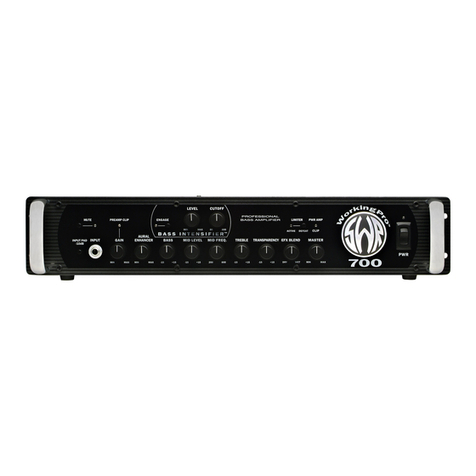
SWR
SWR WorkingPro WorkingPro 700 User manual
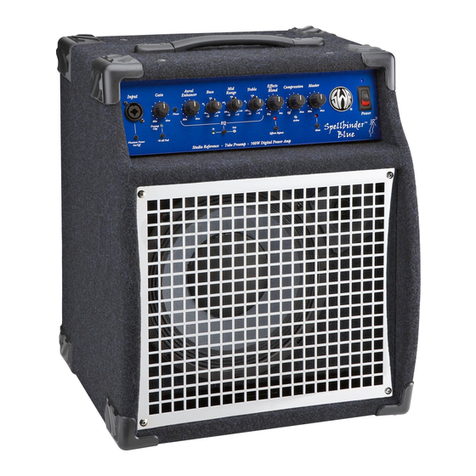
SWR
SWR Spellbinder Blue User manual

SWR
SWR Baby Blue II User manual
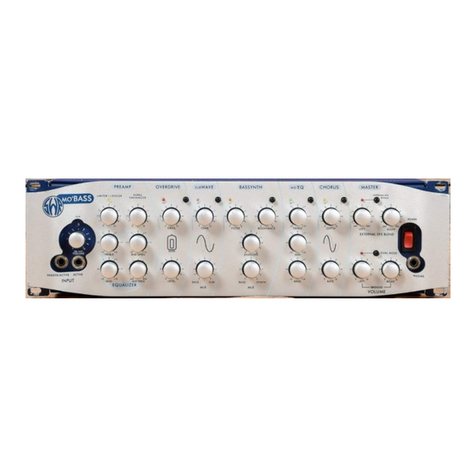
SWR
SWR Mo' Bass User manual

SWR
SWR Marcus Miller User manual
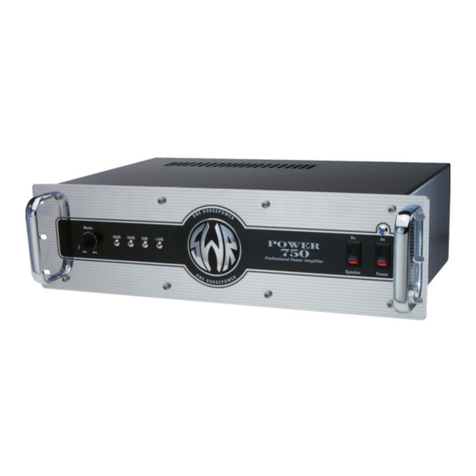
SWR
SWR Amplifier POWER 750 User manual

SWR
SWR California Blonde User manual

SWR
SWR WORKINGMAN'S 10 User manual
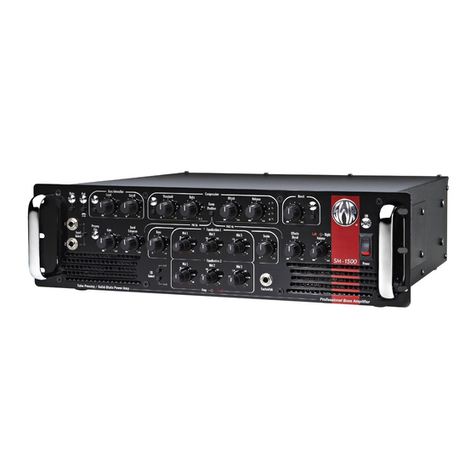
SWR
SWR SM-1500 User manual



